英语倒装句的九种分类讲解
- 格式:doc
- 大小:36.50 KB
- 文档页数:12
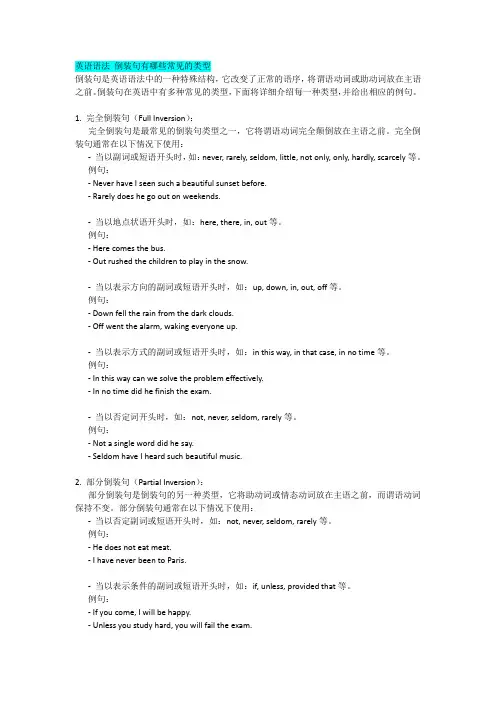
英语语法倒装句有哪些常见的类型倒装句是英语语法中的一种特殊结构,它改变了正常的语序,将谓语动词或助动词放在主语之前。
倒装句在英语中有多种常见的类型,下面将详细介绍每一种类型,并给出相应的例句。
1. 完全倒装句(Full Inversion):完全倒装句是最常见的倒装句类型之一,它将谓语动词完全颠倒放在主语之前。
完全倒装句通常在以下情况下使用:-当以副词或短语开头时,如:never, rarely, seldom, little, not only, only, hardly, scarcely等。
例句:- Never have I seen such a beautiful sunset before.- Rarely does he go out on weekends.-当以地点状语开头时,如:here, there, in, out等。
例句:- Here comes the bus.- Out rushed the children to play in the snow.-当以表示方向的副词或短语开头时,如:up, down, in, out, off等。
例句:- Down fell the rain from the dark clouds.- Off went the alarm, waking everyone up.-当以表示方式的副词或短语开头时,如:in this way, in that case, in no time等。
例句:- In this way can we solve the problem effectively.- In no time did he finish the exam.-当以否定词开头时,如:not, never, seldom, rarely等。
例句:- Not a single word did he say.- Seldom have I heard such beautiful music.2. 部分倒装句(Partial Inversion):部分倒装句是倒装句的另一种类型,它将助动词或情态动词放在主语之前,而谓语动词保持不变。
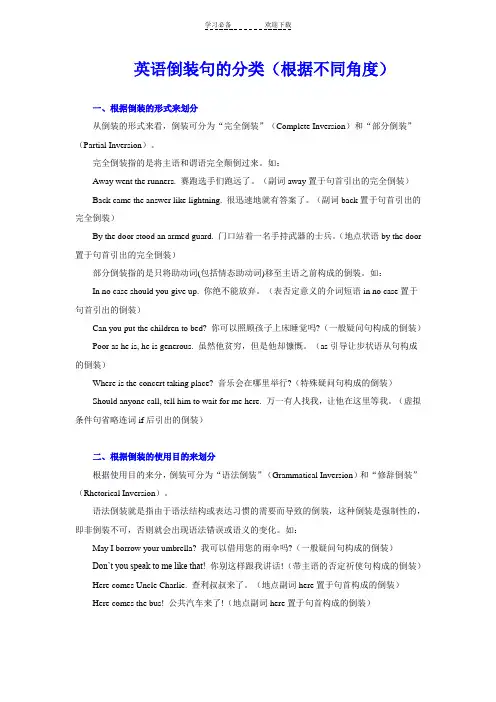
英语倒装句的分类(根据不同角度)一、根据倒装的形式来划分从倒装的形式来看,倒装可分为“完全倒装”(Complete Inversion)和“部分倒装”(Partial Inversion)。
完全倒装指的是将主语和谓语完全颠倒过来。
如:Away went the runners. 赛跑选手们跑远了。
(副词away置于句首引出的完全倒装)Back came the answer like lightning. 很迅速地就有答案了。
(副词back置于句首引出的完全倒装)By the door stood an armed guard. 门口站着一名手持武器的士兵。
(地点状语by the door 置于句首引出的完全倒装)部分倒装指的是只将助动词(包括情态助动词)移至主语之前构成的倒装。
如:In no case should you give up. 你绝不能放弃。
(表否定意义的介词短语in no case置于句首引出的倒装)Can you put the children to bed? 你可以照顾孩子上床睡觉吗?(一般疑问句构成的倒装)Poor as he is, he is generous. 虽然他贫穷,但是他却慷慨。
(as引导让步状语从句构成的倒装)Where is the concert taking place? 音乐会在哪里举行?(特殊疑问句构成的倒装)Should anyone call, tell him to wait for me here. 万一有人找我,让他在这里等我。
(虚拟条件句省略连词if后引出的倒装)二、根据倒装的使用目的来划分根据使用目的来分,倒装可分为“语法倒装”(Grammatical Inversion)和“修辞倒装”(Rhetorical Inversion)。
语法倒装就是指由于语法结构或表达习惯的需要而导致的倒装,这种倒装是强制性的,即非倒装不可,否则就会出现语法错误或语义的变化。
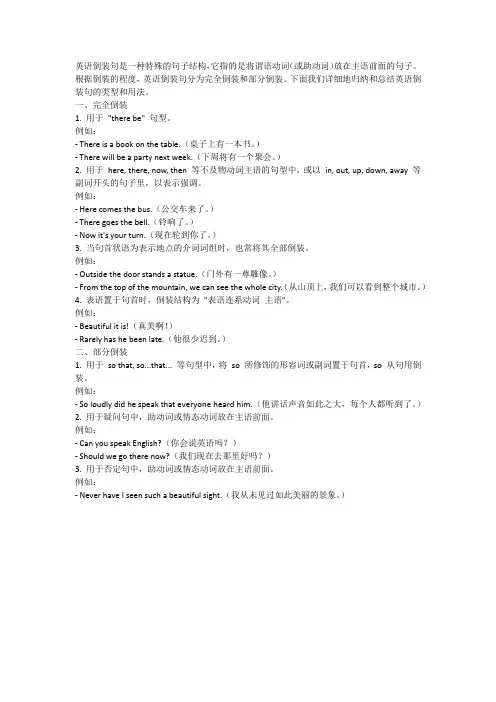
英语倒装句是一种特殊的句子结构,它指的是将谓语动词(或助动词)放在主语前面的句子。
根据倒装的程度,英语倒装句分为完全倒装和部分倒装。
下面我们详细地归纳和总结英语倒装句的类型和用法。
一、完全倒装1. 用于"there be" 句型。
例如:- There is a book on the table.(桌子上有一本书。
)- There will be a party next week.(下周将有一个聚会。
)2. 用于here, there, now, then 等不及物动词主语的句型中,或以in, out, up, down, away 等副词开头的句子里,以表示强调。
例如:- Here comes the bus.(公交车来了。
)- There goes the bell.(铃响了。
)- Now it's your turn.(现在轮到你了。
)3. 当句首状语为表示地点的介词词组时,也常将其全部倒装。
例如:- Outside the door stands a statue.(门外有一尊雕像。
)- From the top of the mountain, we can see the whole city.(从山顶上,我们可以看到整个城市。
)4. 表语置于句首时,倒装结构为"表语连系动词主语"。
例如:- Beautiful it is!(真美啊!)- Rarely has he been late.(他很少迟到。
)二、部分倒装1. 用于so that, so...that... 等句型中,将so 所修饰的形容词或副词置于句首,so 从句用倒装。
例如:- So loudly did he speak that everyone heard him.(他讲话声音如此之大,每个人都听到了。
)2. 用于疑问句中,助动词或情态动词放在主语前面。
例如:- Can you speak English?(你会说英语吗?)- Should we go there now?(我们现在去那里好吗?)3. 用于否定句中,助动词或情态动词放在主语前面。
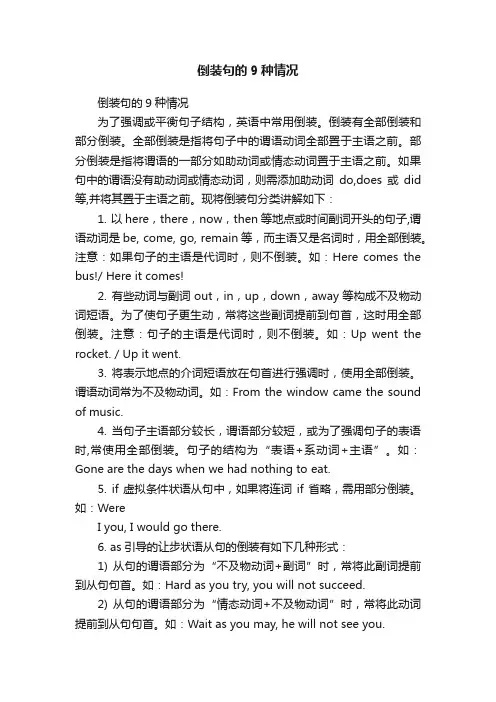
倒装句的9种情况倒装句的9种情况为了强调或平衡句子结构,英语中常用倒装。
倒装有全部倒装和部分倒装。
全部倒装是指将句子中的谓语动词全部置于主语之前。
部分倒装是指将谓语的一部分如助动词或情态动词置于主语之前。
如果句中的谓语没有助动词或情态动词,则需添加助动词do,does或did 等,并将其置于主语之前。
现将倒装句分类讲解如下:1. 以here,there,now,then等地点或时间副词开头的句子,谓语动词是be, come, go, remain等,而主语又是名词时,用全部倒装。
注意:如果句子的主语是代词时,则不倒装。
如:Here comes the bus!/ Here it comes!2. 有些动词与副词out,in,up,down,away等构成不及物动词短语。
为了使句子更生动,常将这些副词提前到句首,这时用全部倒装。
注意:句子的主语是代词时,则不倒装。
如:Up went the rocket. / Up it went.3. 将表示地点的介词短语放在句首进行强调时,使用全部倒装。
谓语动词常为不及物动词。
如:From the window came the sound of music.4. 当句子主语部分较长,谓语部分较短,或为了强调句子的表语时,常使用全部倒装。
句子的结构为“表语+系动词+主语”。
如:Gone are the days when we had nothing to eat.5. if虚拟条件状语从句中,如果将连词if省略,需用部分倒装。
如:WereI you, I would go there.6. as引导的让步状语从句的倒装有如下几种形式:1) 从句的谓语部分为“不及物动词+副词”时,常将此副词提前到从句句首。
如:Hard as you try, you will not succeed.2) 从句的谓语部分为“情态动词+不及物动词”时,常将此动词提前到从句句首。
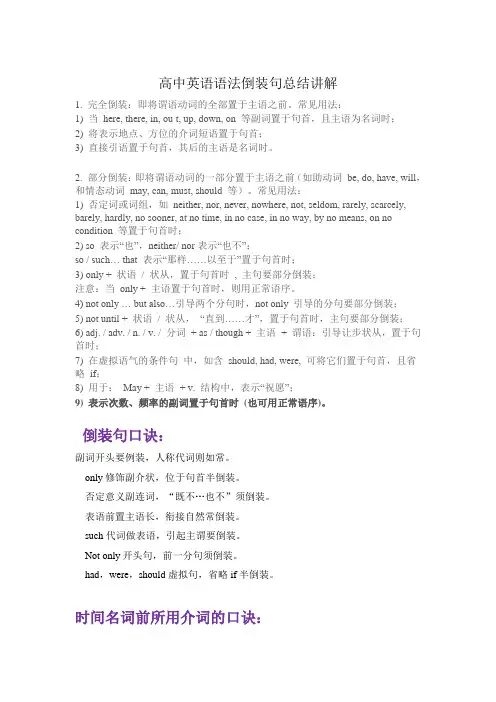
高中英语语法倒装句总结讲解1. 完全倒装:即将谓语动词的全部置于主语之前。
常见用法:1) 当here, there, in, ou t, up, down, on 等副词置于句首,且主语为名词时;2) 将表示地点、方位的介词短语置于句首;3) 直接引语置于句首,其后的主语是名词时。
2. 部分倒装:即将谓语动词的一部分置于主语之前(如助动词be, do, have, will,和情态动词may, can, must, should 等)。
常见用法:1) 否定词或词组,如neither, nor, never, nowhere, not, seldom, rarely, scarcely, barely, hardly, no sooner, at no time, in no case, in no way, by no means, on no condition 等置于句首时;2) so 表示“也”,neither/ nor表示“也不”;so / such… that 表示“那样……以至于”置于句首时;3) only + 状语/ 状从,置于句首时, 主句要部分倒装;注意:当only + 主语置于句首时,则用正常语序。
4) not only … but also…引导两个分句时,not only 引导的分句要部分倒装;5) not until + 状语/ 状从,“直到……才”,置于句首时,主句要部分倒装;6) adj. / adv. / n. / v. / 分词+ as / though + 主语+ 谓语:引导让步状从,置于句首时;7) 在虚拟语气的条件句中,如含should, had, were, 可将它们置于句首,且省略if;8) 用于:May + 主语+ v. 结构中,表示“祝愿”;9) 表示次数、频率的副词置于句首时(也可用正常语序)。
倒装句口诀:副词开头要例装,人称代词则如常。
only修饰副介状,位于句首半倒装。
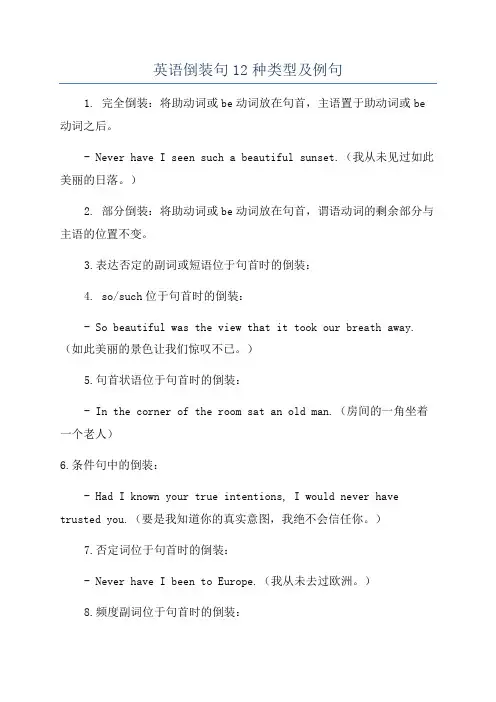
英语倒装句12种类型及例句1. 完全倒装:将助动词或be动词放在句首,主语置于助动词或be 动词之后。
- Never have I seen such a beautiful sunset.(我从未见过如此美丽的日落。
)2. 部分倒装:将助动词或be动词放在句首,谓语动词的剩余部分与主语的位置不变。
3.表达否定的副词或短语位于句首时的倒装:4. so/such位于句首时的倒装:- So beautiful was the view that it took our breath away.(如此美丽的景色让我们惊叹不已。
)5.句首状语位于句首时的倒装:- In the corner of the room sat an old man.(房间的一角坐着一个老人)6.条件句中的倒装:- Had I known your true intentions, I would never have trusted you.(要是我知道你的真实意图,我绝不会信任你。
)7.否定词位于句首时的倒装:- Never have I been to Europe.(我从未去过欧洲。
)8.频度副词位于句首时的倒装:- Rarely do we see such dedication.(我们很少见到如此的奉献精神。
)9.祈使句或祈使句部分的倒装:- Stand up!(站起来!)- Be quiet, please.(请安静。
)10. only位于句首时的倒装:- Only by working hard can you achieve your goals.(只有通过努力工作,你才能实现目标。
)11.地点状语置于句首时的倒装:- In the garden were beautiful flowers.(花园里有美丽的花朵。
)12.宾语置于句首时的倒装:- A love like this I have never felt before.(我之前从未感受过如此的爱。
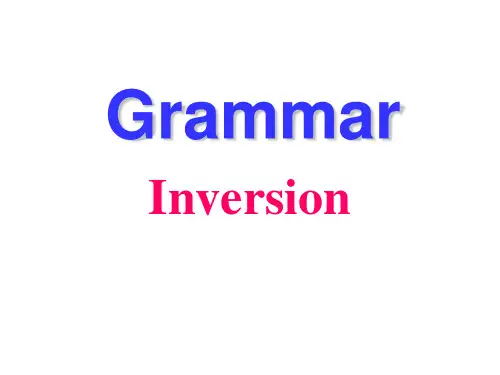
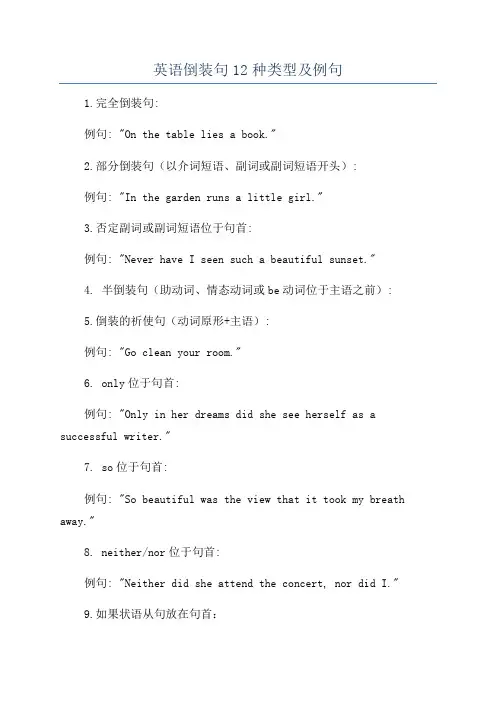
英语倒装句12种类型及例句1.完全倒装句:例句: "On the table lies a book."2.部分倒装句(以介词短语、副词或副词短语开头):例句: "In the garden runs a little girl."3.否定副词或副词短语位于句首:例句: "Never have I seen such a beautiful sunset."4. 半倒装句(助动词、情态动词或be动词位于主语之前):5.倒装的祈使句(动词原形+主语):例句: "Go clean your room."6. only位于句首:例句: "Only in her dreams did she see herself as a successful writer."7. so位于句首:例句: "So beautiful was the view that it took my breath away."8. neither/nor位于句首:例句: "Neither did she attend the concert, nor did I."9.如果状语从句放在句首:10.条件从句位于句首:例句: "Should he fail the exam, he will have to retake the course."11.介词短语或副词短语位于句首:例句: "In the corner sat a small dog."12. or/ nor引导的短语或句子位于句首:。
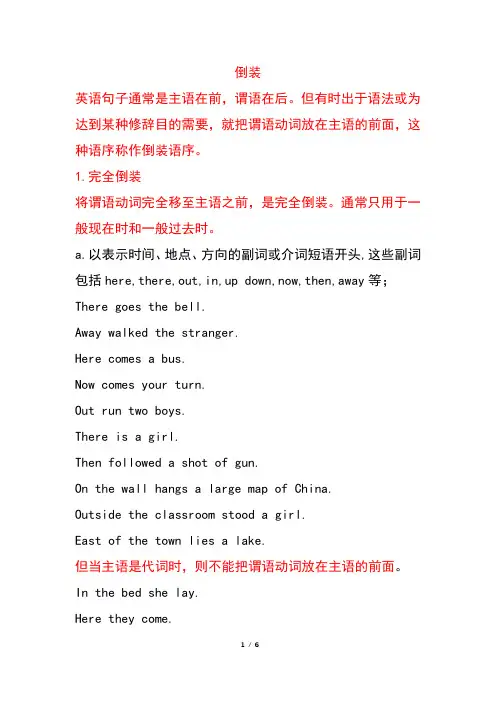
倒装英语句子通常是主语在前,谓语在后。
但有时出于语法或为达到某种修辞目的需要,就把谓语动词放在主语的前面,这种语序称作倒装语序。
1.完全倒装将谓语动词完全移至主语之前,是完全倒装。
通常只用于一般现在时和一般过去时。
a.以表示时间、地点、方向的副词或介词短语开头,这些副词包括here,there,out,in,up down,now,then,away等;There goes the bell.Away walked the stranger.Here comes a bus.Now comes your turn.Out run two boys.There is a girl.Then followed a shot of gun.On the wall hangs a large map of China.Outside the classroom stood a girl.East of the town lies a lake.但当主语是代词时,则不能把谓语动词放在主语的前面。
In the bed she lay.Here they come.Away they went.There he is.Back he fight.b.进行时和被动语态的倒装A boy is sitting at the table.(正常语序)Sitting at the table is a boy.(倒装语序)At the table is sitting a boy. (倒装语序)An old man was killed on the road. (正常语序)Killed on the road was an old man. (倒装语序)On the road was killed an old man. (倒装语序)2.部分倒装部分倒装是指将谓语动词的一部分(Be动词、助动词、情态动词,如无,加do、did、does)放在主语的前面。
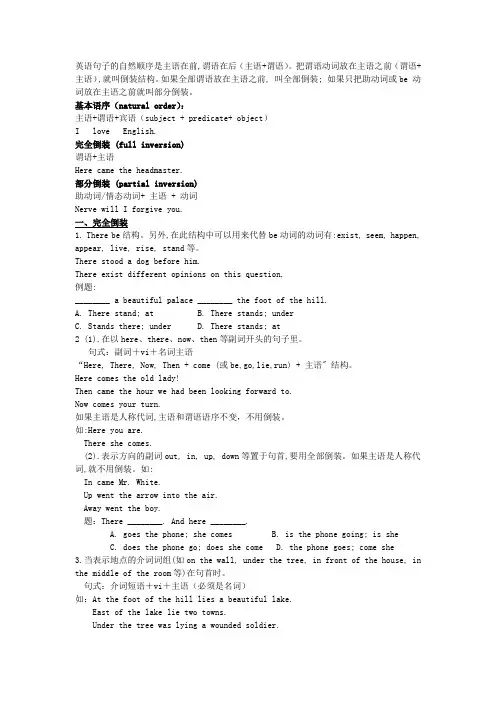
英语句子的自然顺序是主语在前,谓语在后(主语+谓语)。
把谓语动词放在主语之前(谓语+主语),就叫倒装结构。
如果全部谓语放在主语之前, 叫全部倒装; 如果只把助动词或be 动词放在主语之前就叫部分倒装。
基本语序(natural order):主语+谓语+宾语(subject + predicate+ object)I love English.完全倒装 (full inversion)谓语+主语Here came the headmaster.部分倒装 (partial inversion)助动词/情态动词+ 主语 + 动词Nerve will I forgive you.一、完全倒装1. There be结构。
另外,在此结构中可以用来代替be动词的动词有:exist, seem, happen, appear, live, rise, stand等。
There stood a dog before him.There exist different opinions on this question.例题:________ a beautiful palace ________ the foot of the hill.A. There stand; atB. There stands; underC. Stands there; underD. There stands; at2 (1).在以here、there、now、then等副词开头的句子里。
句式:副词+vi+名词主语“Here, There, Now, Then + come (或be,go,lie,run) + 主语" 结构。
Here comes the old lady!Then came the hour we had been looking forward to.Now comes your turn.如果主语是人称代词,主语和谓语语序不变,不用倒装。
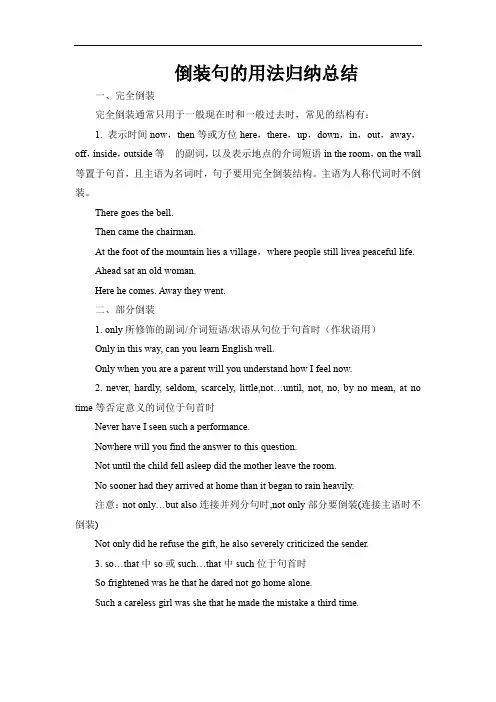
倒装句的用法归纳总结一、完全倒装完全倒装通常只用于一般现在时和一般过去时,常见的结构有:1. 表示时间now,then等或方位here,there,up,down,in,out,away,off,inside,outside等的副词,以及表示地点的介词短语in the room,on the wall 等置于句首,且主语为名词时,句子要用完全倒装结构。
主语为人称代词时不倒装。
There goes the bell.Then came the chairman.At the foot of the mountain lies a village,where people still livea peaceful life.Ahead sat an old woman.Here he comes. Away they went.二、部分倒装1. only所修饰的副词/介词短语/状语从句位于句首时(作状语用)Only in this way, can you learn English well.Only when you are a parent will you understand how I feel now.2. never, hardly, seldom, scarcely, little,not…until, not, no, by no mean, at no time等否定意义的词位于句首时Never have I seen such a performance.Nowhere will you find the answer to this question.Not until the child fell asleep did the mother leave the room.No sooner had they arrived at home than it began to rain heavily.注意:not only…but also连接并列分句时,not only部分要倒装(连接主语时不倒装)Not only did he refuse the gift, he also severely criticized the sender.3. so…that中so或such…that中such位于句首时So frightened was he that he dared not go home alone.Such a careless girl was she that he made the mistake a third time.4. so位于句首表示前句的内容也同样适用于后一个人或物时(只能是肯定句,且前后两句主语不同); neither/nor用于句首,表示前句的否定内容也适用于后一句的人/物时(只能用于否定句,且前后两句主语不同)He likes chatting. So does his wife.If you won't go, neither will I.5. 在虚拟语气中,如果if条件从句有系动词were或助动词should/had,可以把其置于句首,同时省去if.Were it to rain, we would cancel the plan.。
高中英语倒装句讲解高中英语倒装句讲解一、什么是倒装句倒装句是英语中常用的一种语法结构,它通过改变句子中词语的正常顺序,使句子更加生动、形象。
在倒装句中,主语和宾语的位置常常颠倒,同时句子结尾的语态也不同于正常语序。
二、倒装句的种类1、完全倒装句:这种类型的倒装句把主语和宾语完全颠倒,让宾语出现在主语之前。
例如:“Here comes the bus”(公交车来了)。
2、部分倒装句:这种倒装句只把助动词、系动词或情态动词放在主语前面,其余部分仍保持正常语序。
例如:“Are you ready to leave?”(你准备好离开了吗?)三、如何使用倒装句1、为了让句子更加生动,可以使用倒装句。
例如,比起常规语序的“The book is on the table”,使用倒装句“On the table is the book”更能突出物体的位置。
2、在一些情况下,使用倒装句可以更好地表达对比、惊讶等感情色彩。
例如,“Out rushed the dog”比“The dog rushed out”更能表达出狗冲出来的急迫感。
3、在一些疑问句中,为了更好地表达疑问点,需要使用倒装句。
例如,“Did he go to school yesterday?”比“Did he go to school?”更加具体。
四、注意事项1、在使用倒装句时,要注意句子的逻辑性和连贯性,避免出现歧义或误解。
2、在写作中,要根据文章的整体风格和语境来选择使用倒装句,不要过度使用,以免影响阅读体验。
3、在学习倒装句时,要掌握不同类型的倒装句的语法规则,并通过大量的阅读和写作实践来提高自己的语感和应用能力。
总之,掌握英语倒装句对于提高英语表达能力和写作水平都非常重要。
通过深入理解倒装句的语法规则,正确运用倒装句,可以让我们的英语表达更加生动、丰富,更具有表现力和感染力。
倒装句详解概念:用以表示一定句子结构的需要和强调某一句子成分的需要, 分为完全倒装和部分倒装.一.完全倒装:句子中的谓语动词全部置于主语之前.此结构通常只用与一般现在时和一般过去时.1.以here, there, now, then等副词或out, in, up, down, away等表示运动方向的副词或地点状语置于句首以示强调, 句子要全部倒装, 谓语动词常用come,go, be, lie,run,rush等.2. 表示地点的介词短语位于句首时A beautiful lake lies at the foot of the hillAt the foot of the hill lies a beautiful lake.注意:在上述句子中, 如果主语为人称代词, 则主、谓不需要倒装.In he came and back he went again.Away he went .二.部分倒装:be/助动词/情态动词提前到主语的前面.Is am are was were(be动词)do does did(助动词)can could would may will might(情态动词)等1.only所修饰的副词、介词短语或状语从句放在句首时, 要进行部分倒装.Only then did I realize the importance of learning English.Only after he came back was I able to see him.注:only修饰主语, 仍用自然语序, 如:Only socialism can save China.I seldom go to the cinema.倒装:Seldom do I go to the cinema.我很少去看电影.I have never seen such a performance.倒装:Never have I seen such a performance.我从来没有看过这样的表演.2.否定副词及介词短语的否定词位于句首时.高考常考的这类词或词语有:never , not, seldom, hardly, little, nowhere, by no means, in no time等.3.not until 引导的从句位于句首引起的主句部分倒装He didn’t finish his homework until his mother came back.倒装:Not until his mother came back did he finish his homework.直到他的妈妈回来, 他才完成作业.The mother didn’t leave the room until the child fell asleep.倒装:Not until the child fell asleep did the mother leave the room.等到孩子睡着了, 妈妈才离开房间.注意:当Not until引出主从复合句, 主句倒装, 从句不倒装.4、as/ though (虽然, 尽管)引导的让步状语从句名词\形容词\副词\分词+as\though+主语+其他Although I am ugly, I am gentle.倒装:Ugly as I am, I am gentle.Though he is a child, he has to make a living.倒装:Child as he is, he has to make a living.注意:从句的表语是名词, 其名词前不加任何冠词5.用于so nor neither 开头的句子A、So +be/助动词/情态动词+主语某人也是如此Nor/neither +be/助动词/情态动词+主语某人也不是如此1). 他喜欢读书, 我也是.He likes reading very much. So do I .2). 我从来没有去过广州大学, 他也是.I have never been to Guangzhou University, neither/ nor has he.Betty is a nice girl. So she isB、So +主语+be/助动词/情态动词某人确实如此6.在hardly/scarcely/…when;no sooner…than; not only … but also;so...that; such…that 的倒装句中, 前倒后不倒. hardly/scarcely/ no sooner后句子的谓语用had done, when/than后句子的谓语用一般过去时(1) Hardly / Scarcely had he fallen asleep when a loud knock at the door awaked him.(2) No sooner had I reached the station than train moved.(3) Not only is he interested in football but also he plays it well.(4) So hard does he work that he has made great progress in English.7. If 虚拟条件从句中.从句有(were/should/had)1)If I were you, I would work hard. 倒装:Were I you, I would work hard.2) If it should rain tomorrow, we would put off our meeting.倒装: Should it rain tomorrow, we would put off our meeting.3)If he had followed my advice, he would have succeeded.倒装:Had he followed my advice, he would have succeeded.8.May置句首, 表示祝愿.May you succeed.祝你成功!补充知识1.全部倒装全部倒装是只将句子中的谓语动词全部置于主语之前.此结构通常只用于一般现在时和一般过去时.常见的结构有:1)here, there, now, then, thus等副词置于句首, 谓语动词常用be, come, go, lie, run等表示来去或状态的动词.Then came the chairman. 那时总裁来了.Here is your letter. 你的信.2)表示运动方向的副词或地点状语置于句首, 谓语表示运动的动词.Out rushed a missile from under the bomber. 轰炸机肚底下窜出一枚导弹.Ahead sat an old woman. 前面坐着一个老妪.注意:上述全部倒装的句型结构的主语必须是名词, 如果主语是人称代词则不能完全倒装.Here he comes. 他来了.Away they went. 他们走开了.2.部分倒装部分倒装是指将谓语的一部分如助动词或情态倒装至主语之前.如果句子的谓语没有助动词或情态动词, 则需添加助动词do, does或did, 并将其置于主语之前.1.句首为否定或半否定的词语, 如no, not, never, seldom, little, hardly, at no time决不, in no way, not until… 等. Never have I seen such a performance. 从未见过如此糟糕的表演.Nowhere will you find the answer to this question. 无论如何你不会找到这个问题的答案的.Not until the child fell asleep did the mother leave the room. 母亲一直到孩子入睡后离开房间.2.当Not until引出主从复合句, 主句倒装, 从句不倒装.注意:如否定词不在句首不倒装.I have never seen such a performance. ---never have I seen such a performance.The mother didn\'t leave the room until the child fell asleep.---not until the child fell asleep the mother did leave the room.改写为正常语序为, Man did not know what heat is until the early years of the 19th. 现在将not提前, 后面就不能再用否定了,否则意思就变了.3.以否定词开头作部分倒装如Not only…but also, Hardly/Scarcely…when, No sooner… than等, 要倒装.Not only did he refuse the gift, he also severely criticized the sender. 他没有收下礼物, 还狠狠批评了送礼的人. Hardly had she gone out when a student came to visit her. 她刚出门, 就有个学生来访.No sooner had she gone out than a student came to visit her. 她刚出门, 就有个学生来访.4. so, neither, nor作部分倒装用这些词表示\"也\"、\"也不\" 的句子要部分倒装.Tom can speak French. So can Jack. 汤姆会讲法语, 杰克也会.If you won\'t go, neither will I.你不去, 我也不去.注意:当so引出的句子用以对上文内容加以证实或肯定时, 不可用倒装结构.意为\"的确如此\".Tom asked me to go to play football and so I did. 汤姆邀我去踢球, 我去了.---It\'s raining hard.---So it is. 雨下得真大.是呀.5. only在句首倒装的情况.Only in this way, can you learn English well. 只有这样, 你才能学好英语.Only after being asked three times did he come to the meeting. 叫了三次, 他才来参加会议.如果句子为主从复合句, 则主句倒装, 从句不倒装.Only when he is seriously ill does he ever stay in bed. 病得狠重时, 他才卧床休息.6. as, though 引导的倒装句as / though引导的让步从句必须将表语或状语提前(形容词, 副词, 分词, 实义动词提前).但需注意:1)句首名词不能带任何冠词.2)句首是实义动词, 其他助动词放在主语后.如果实义动词有宾语和状语, 随实义动词一起放在主语之前.Try hard as he will, he never seems able to do the work satisfactorily. 他工作很努力, 但总不能让人满意.注意:让步状语从句中, 有though, although时, 后面的主句不能有but, 但是though 和yet可连用.7. 其他部分倒装1)so… that 句型中的so 位于句首时, 需倒装.So frightened was he that he did not dare to move an inch. 他害怕得很, 动也不敢动.2)在某些表示祝愿的句型中.例如:May you all be happy. 愿你们都快乐.3)在虚拟语气条件句中从句谓语动词有were, had, should等词, 可将if 省略, 把were, had, should 移到主语之前, 采取部分倒装.例如:Were I you, I would try it again. 我是你的话, 就再试一次.深化拓展一、全倒装:五全=有时表地方经常与be/come/exist/fall/follow/go/remain/seem/stand(表示移动或动态的不及物动词连用)或用表示类似存在观念的其他不及物动词如:live, stand, come, lie, flow, enter, rise 和appear等1、有:在there be结构里There is a box on the table.桌子上面有一个盒子.2、时:表示时间副词, 如:now, then,Now comes your turn.现在轮到你了.3、表:表语放句子前,表语+系动词+主语的结构Present at the party were Mr. Green and many other guests.格林先生和其他的客人在这个聚会上.Seated on the ground are a group of young men.一群年轻人坐在了地上.4、地:地点状语放在句首In south of the river lies a small factory. 小工厂位于河的南方.From the valley came a cry.山谷传来一阵哭声.5、方:表方位的副词here, there 或out, in, up, down, away, off等标志词放在句首There lies a large wheat field in front of the house.房子前面有一大片麦田.Off all the lights went when I came in.当我进来时, 所有的灯都灭了.二、半倒装:八部=不只让步也常需(虚)如此祝福1、不表示否定①no, not, never, hardly, no,not,never,hardly,barely,seldom,rarely,scarcely,no longer,nowhereNever have I been to Beijing.我从没有没有去过北京.②绝不:at n time, in no way, by no means, on no account, in no case, in/under no circumstanceAt no time can we give up.我们决不能放弃.③Not until ...:直到Not until my mother came home did I go to bed.知道我妈妈回家我才睡觉.④Hardly/ Scarcely...(过完)...when...(一过)...:一...就...No sooner...(过完)...than...(一过)...:一...就...He had hardly got home when it happened to rain.=Had he hardly got home when it happened to rain.他一到家碰巧就下雨了.⑤Not only......but also......:(前倒后不倒)Not only did he refuse the gift, he also severely criticized the sender.他没有收下礼物, 还狠狠批评了送礼的人2、只:only所修饰的副词、介词短语或状语从句放在句子开头时.Only then did I realize that I was wrong.只有到那时我才意识到我错了.Only in this way can you learn from your mistake.只有用这样的方法你可以从错误中学习.Only when the war was over in 1918 was he able to get happily back to work.只有当战争于1918年结束时候, 他才能够快乐地回到工作当中.※当only 之后所接的不是状语时不可以用倒装Only Comrade Zhang knows about the matter..只有张同志知道这件事.3、让步:as/though/although引导让步状语从句时要倒装(形/副/名/动+as +主语+ 谓语)Proud as they are, they are afraid to see me.尽管他们自豪, 但是他们还怕见到我.Child as he is, he seems to know everything.(child前不加冠词)尽管他是个孩子, 但他好像知道一切.Hard as he worded, he made little progress.尽管他努力工作, 但是几乎没什么进步.※以上句中as可以替换though/although, 但是as更加常用.4、也:so/nor/neither开头,表示谓语所述的情况也适用于另一个人或一事物的肯定或否定句so用于肯定句, 表示也一样也这样;nor/neither用于否定句, 表示同样也不, 也不这样.I am watching TV. So is she.我正在看电视, 她也在看.My parents didn't watch TV last night. Neither (Nor)did I.我父母昨晚没有看电视, 我也没有看.※表示两人的同样一个情况时, 只能表示一件事, 即上、下句所使用的动词、时态要一致.5、常:表示频度副词如:often、many a time, now and again等经常用于正式的文体中Often did he advise them not to smoke.他经常建议他们不要抽烟.6、需=虚拟:省略if的虚拟条件句, 把助动词were、had、should提到主语前面时Had it not been for your help, we shouldn't have achieved so much.要不是你的帮助, 我们不可能收获这么多.7、如此:so/such …that….从句中, 当so+形容词/副词或such+名词位于句首时.So exhausted was she that she wanted to have a rest.他是如此地疲惫以至于想要休息一下.8、祝福:当may放在句首, 表达祝愿时.May you succeed! 祝你成功!。
倒装句的种类及常见句型倒装句是英语中常见的一种语法结构,它与普通的句式结构不同,通常会将主语和谓语的顺序颠倒。
倒装句在表达强调、对比、条件等意义时具有独特的作用,同时也是考试和日常写作中需要掌握的重要语法知识。
本文将介绍倒装句的种类及常见句型。
一、完全倒装句完全倒装句在句子中把整个谓语都移至主语之前,常见的结构有以下几种:1. 在助动词或情态动词之前倒装:Never had I seen such a beautiful sunset before.(我以前从未见过如此美丽的日落。
)Not only does she speak English fluently, but she also speaks French.(她不仅英语讲得流利,而且还会说法语。
)2. 在表示方位、地点或副词(adverbs of place)之前倒装:Out rushed the students as soon as the bell rang.(铃一响,学生们都冲了出去。
)Here comes the bus.(车来了。
)3. 在表示条件和让步的状语从句之前倒装:Should you have any questions, please feel free to ask.(如果你有任何问题,请随时提问。
)However hard he worked, he couldn't pass the exam.(无论他多努力,他都无法通过考试。
)二、部分倒装句部分倒装句是指将谓语的一部分与主语颠倒,常见的结构有以下几种:1. 在否定副词或短语之前倒装:Not until midnight did the party finally come to an end.(直到午夜,聚会才最终结束。
)At no time did she mention his name.(她从不提他的名字。
)2. 在连词so、neither、nor等之后倒装:They were tired, and so were we.(他们累了,我们也是。
英语倒装句的九种分类讲解为了强调或平衡句子结构,英语中常用倒装。
倒装有全部倒装和部分倒装。
全部倒装是指将句子中的谓语动词全部置于主语之前。
部分倒装是指将谓语的一部分如助动词或情态动词置于主语之前。
如果句中的谓语没有助动词或情态动词,则需添加助动词do,does或did等,并将其置于主语之前。
现将倒装句分类讲解如下:1. 以here,there,now,then等地点或时间副词开头的句子,谓语动词是be, come, go, remain等,而主语又是名词时,用全部倒装。
注意:如果句子的主语是代词时,则不倒装。
如:Here comes the bus!/ Here it comes!2. 有些动词与副词out,in,up,down,away等构成不及物动词短语。
为了使句子更生动,常将这些副词提前到句首,这时用全部倒装。
注意:句子的主语是代词时,则不倒装。
如:Up went the rocket. / Up it went.3. 将表示地点的介词短语放在句首进行强调时,使用全部倒装。
谓语动词常为不及物动词。
如: From the window came the sound of music.4. 当句子主语部分较长,谓语部分较短,或为了强调句子的表语时,常使用全部倒装。
句子的结构为“表语+系动词+主语”。
如: Gone are the days when we had nothing to eat.5. if虚拟条件状语从句中,如果将连词if省略,需用部分倒装。
如:WereI you, I would go there.6. as引导的让步状语从句的倒装有如下几种形式:1) 从句的谓语部分为“不及物动词+副词”时,常将此副词提前到从句句首。
如:Hard as you try, you will not succeed.2) 从句的谓语部分为“情态动词+不及物动词”时,常将此动词提前到从句句首。
如: Wait as you may, he will not see you.3) 从句的谓语部分是“系动词+形容词”时,常将此表语形容词提前到从句句首。
英语倒装句12种类型1、“there be”结构在这一结构里,there是引导词,主语在be后。
2、疑问句疑问句为倒装形式。
3、here、there等副词开头的句子(部分)。
在here、there等副词开头的某些句子中(要用一般现在时态)(前两个例句);如果主语是人称代词,主语和主要动词的词序不变。
(完全倒装)4、重复倒装句型在以so、nor、neither开头,表示谓语所述的情况也适用于另一个人或一事物的肯定或否定句中。
so用于肯定句,表示“也一样”、“也这样”;nor、neither用于否定句,表示“同样也不,也不这样”。
5、直接引语的全部或一部分放在句首时,主句中的主谓也常直接倒装(完全倒装)。
6、否定副词开头的句子(部分倒装) 在以never、little、hardly、not、only、few、not、seldom等否定副词开头的句子中,采用部分倒装;如果不放在句首就不要倒装。
7、以only所修饰的副词、介词短语或状语从句的句子。
8、地点、方位副词在句首(完全倒装) 为了表达生动,有时把表地点、方位的副词,如up、down、out、away、in等放在句首,同时把谓语动词放在主语之前。
若主语为人称代词,主语和谓语动词的位置不变,只将副词放在句首。
(完全倒装)9、虚拟结构中在虚拟结构中,条件从句的谓语含有were、had和should这三个词是,可省去if,将这些词移至主语之前。
10、as引导的让步状语从句 as引导让步状语从句时要倒装(形容词/副词/名词/动词+as+主语+谓语)。
11、祝愿的句子用于某些表示祝愿的句子里。
12、So+形容词、副词及such置于句首时。
详解英语倒装句的各种句式及⽤法,看完⼀遍掌握全部英语句⼦通常有两种语序:陈述语序和倒装语序。
陈述语序是主语在前,谓语在后;倒装语序是谓语在前,主语在后。
倒装语序⼜分完全倒装和部分倒装。
⼀、完全倒装:将整个谓语提到主语之前1.在There be (exist, happen, live, appear, lie, occur, rise, seem, come, remain, stand等)句型中。
(1)There are at least 2000 people on the square. ⾄少有2000⼈在⼴场上(主语是2000(2)people, 谓语动词是are)(3)There stood a dog before him.⼀只狗站在他⾯前(主语是a dog)(4)There exist different opinions on this question. 关于这个问题,有不同的意见存在(主语是different opinions)2. 以here, there, now, then等开头的句⼦。
(1)Here is the seat for you. 这⼉有⼀个座位给你(主语是the seat)(2)There goes the bell. 铃声响了(主语是the bell)(3)Now comes your turn. 轮到你了(主语是your turn)(4)Then followed three days of heavy rain. 接下来是三天的⼤⾬(主语是heavy rain)3. 在象声词或以out, in, up, down, away等副词开头的句⼦⾥。
(1)Crackle, crackle came the gun and the young soldier felt very frightened. 枪声叭叭作响,这个年轻的⼠兵感到很害怕。
(主语是the gun)(2)Out rushed the children. 孩⼦们冲了出去。
英语倒装句的九种分类讲解为了强调或平衡句子结构,英语中常用倒装。
倒装有全部倒装和部分倒装。
全部倒装是指将句子中的谓语动词全部置于主语之前。
部分倒装是指将谓语的一部分如助动词或情态动词置于主语之前。
如果句中的谓语没有助动词或情态动词,则需添加助动词do,does或did等,并将其置于主语之前。
现将倒装句分类讲解如下:1. 以here,there,now,then等地点或时间副词开头的句子,谓语动词是be, come, go, re main等,而主语又是名词时,用全部倒装。
注意:如果句子的主语是代词时,则不倒装。
如:Here comes the bus!/ Here it comes!2. 有些动词与副词out,in,up,down,away等构成不及物动词短语。
为了使句子更生动,常将这些副词提前到句首,这时用全部倒装。
注意:句子的主语是代词时,则不倒装。
如:Up went the rocket. / Up it went.3. 将表示地点的介词短语放在句首进行强调时,使用全部倒装。
谓语动词常为不及物动词。
如: From the window came the sound of music.4. 当句子主语部分较长,谓语部分较短,或为了强调句子的表语时,常使用全部倒装。
句子的结构为“表语+系动词+主语”。
如: Gone are the days when we had nothing to eat.5. if虚拟条件状语从句中,如果将连词if省略,需用部分倒装。
如:Were I you, I would go there.6. as引导的让步状语从句的倒装有如下几种形式:1) 从句的谓语部分为“不及物动词+副词”时,常将此副词提前到从句句首。
如:Hard a s you try, you will not succeed.2) 从句的谓语部分为“情态动词+不及物动词”时,常将此动词提前到从句句首。
如:Wait as you may, he will not see you.3) 从句的谓语部分是“系动词+形容词”时,常将此表语形容词提前到从句句首。
如: P roud as the nobles are, they are afraid to see me.4) 从句的谓语部分是“系动词+单数名词”时,则常将这个表语提前,但要省略名词前的不定冠词。
如: Child as he is, he can tell right from wrong.7. 具有(半)否定意义的词或短语位于句首时,用部分倒装。
如:seldom, rarely, not, neve r, by no means, in no time, hardly...when, no sooner...than, not only...but also等。
如: Not only does he do well in his lessons, but also he often helps others with their lessons.8. “only+状语”位于句首时, 用部分倒装。
如:Only then did I know the importance of Eng lish.9. so...that结构中,有时要强调so所修饰的形容词或副词,常将so 连同它所修饰的形容词或副词一起提前放在句首。
如: So bright was the moon that the flowers seem as bright as by day.英语语法倒装句之部分倒装部分倒装是指将谓语的一部分如助动词或情态倒装至主语之前。
如果句中的谓语没有助动词或情态动词,则需添加助动词do, does或did,并将其置于主语之前。
1)句首为否定或半否定的词语,如no, not, never, seldom, little, hardly, at no time, in no w ay, not until… 等。
Never have I seen such a performance.Nowhere will you find the answer to this question.Not until the child fell asleep did the mother leave the room.当Not until引出主从复合句,主句倒装,从句不倒装。
注意:如否定词不在句首不倒装。
I have never seen such a performance.The mother didn't leave the room until the child fell asleep.典型例题1)Why can't I smoke here?At no time___ in the meeting-roomA. is smoking permittedB.smoking is permittedC. smoking is it permittedD.does smoking permit答案A. 这是一个倒装问题。
当否定词语置于句首以表示强调时,其句中的主谓须用倒装结构。
这些否定词包括no, little, hardly, seldom, never, not only, not until等。
本题的正常语序是 Smoking is permitted in the meeting-room at no time.2) Not until the early years of the 19th century ___ what heat is.A. man did knowB. man knowC. didn't man knowD. did man know答案D.看到Not until…的句型,我们知道为一倒装句,答案在C,D 中选一个。
改写为正常语序为,Man did not know what heat is until the early years of the 19th. 现在将n ot提前,后面就不能再用否定了,否则意思就变了。
倒装句讲解和练习英语句子通常有两种语序:一种主语在前,谓语在后,称为自然语序,另一种谓语在前,主语在后,称为倒装语序按“主语+ 谓语” 这种顺序排列的句子是陈述语序。
如果排列顺序变为“谓语(或谓语一部分)+主语”,就是倒装。
倒装句分为:一、部分倒装就是把谓语中的be动词、助动词或情态动词置于主语前面。
常见于下列几种情况:(一). only所修饰的副词,介词短语或状语从句放在句首时,要用:only+ 状语+ be /助动词/情态动词+主语及其他Only when he told me the news did I know what had happened.Only in this way can you make progress in your English.注意:only修饰主语时,不需要倒装。
1.Only in this way ________to make improvement in the operating sys tem.A. you can hopeB. you did hopeC. can you hopeD. did you hop e(二).含有否定意义的副词或连词放在句首时。
如:never, little, sel dom, not, not only, not until, no sooner (…than), hardly (…when), rarely, scarcely, in no way 等。
We seldom get up at four in the morning.= Seldom do we get up at four in the morning.Not a single word from him could the enemy drag.Rarely have I heard of such a silly thing.(1)hardly…when; scarcely…when…; no sooner…than… 可以用正常语序had hardly done when… did 或用倒装句式Hardly had + 主语+ don e when… did 句式。
h ardly所在的句子用过去完成时。
The bell hardly had rung when the class began.= Hardly had the bell ru ng when the class began.No sooner had he arrived in Beijing than he began to work.(2)not only… but also 如连接两个成分时,不用倒装;连接句子时,前面的句子要用倒装。
Not only was everything that he had taken away from him, but also his German citizenship.Not only is he busy, but also I have a lot of work to do.Not only does he speak English very well, but also he speaks French w ell.2.I finally got the work I dreamed about. Never in all my life______ __ so happy!A. did I feelB. I feltC. I had feltD. had I felt3.Not until I began to work ________how much time I had wasted.A. didn't I realizeB. did I realizeC. I didn't realizeD. I realized4.No sooner___ than it began to rain heavily.A. the game beganB.has the game begunC. did the game beginD.had the game begun(三).在so…that, such…that句型中,若把so, such引导的结构放在句首时。
So frightened was he that he did not dare to move an inch.5.So difficult _____it to live in an English-speaking country that I w as determined to learn English well.A. I've felt B have I felt C. I did feel D. did I feel(四).省略了if的虚拟条件句中,把were, had或should放在句首时。